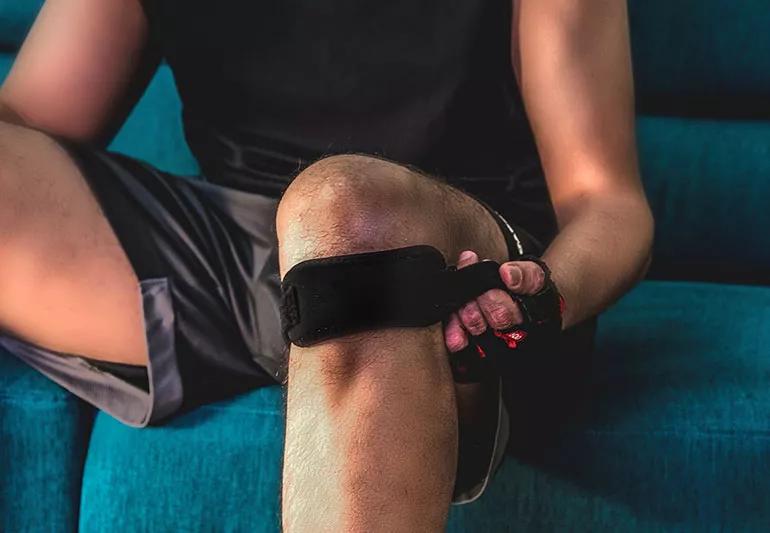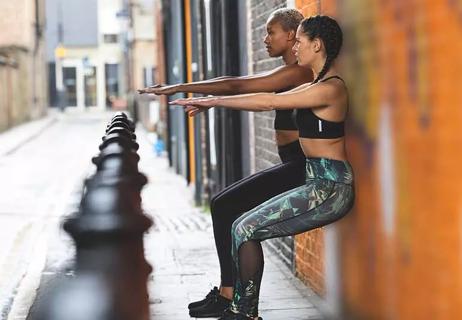The simple and inexpensive band is a proven way to ease your knee pain

A patellar tendon strap certainly doesn’t look like much. The proven relief it can bring your achy knee, however, can seem nothing short of magical.
Advertisement
Cleveland Clinic is a non-profit academic medical center. Advertising on our site helps support our mission. We do not endorse non-Cleveland Clinic products or services. Policy
Wrapping this simple band just below your knee reduces strain on the hard-working tendon connecting your patella (kneecap) and tibia (shinbone). It offers just enough support and stability to ease pain that may pop up during physical activity.
“It really is amazing what that little strap can do,” says sports and medical orthopaedist Dominic King, DO.
Here’s the science behind the sorcery.
Let’s start with a basic anatomical fact: Running, jumping and even walking subject your two knees to an extreme amount of force given an awkward alignment of all the moving parts. From a purely engineering perspective, it is not ideal.
The setup puts repeated stress on the joint that can irritate your patellar tendon – a reality that announces itself through knee pain during physical activity.
Enter the patellar tendon strap.
The adjustable band applies just enough pressure on the patellar tendon to better align it with your kneecap. It changes both the direction and magnitude of the force on the knee while also providing stability, explains Dr. King.
He compares it to how a U-shaped neck pillow works for passengers on an airplane. Basically, a patellar tendon strap keeps the knee in proper alignment to reduce strain.
Advertisement
“It’s a simple and low-risk way to bring some relief,” says Dr. King.
There are three things that matter when you wear a patellar tendon strap: location, location, location. Hitting the proper pressure point on the tendon is key to delivering relief and support, says Dr. King.
The front center of the strap – where there’s typically a puffy pad or cushion – should sit directly under your kneecap where the patellar tendon attaches to the patella.
Tighten the adjustable strap until you feel a bit of pressure on the tendon. “Avoid the temptation to over tighten,” advises Dr. King. This is a support band, after all, not a tourniquet. It shouldn’t leave your lower leg feeling numb or tingly.
Think of a patellar tendon strap like a Band-Aid: It’s useful to address the occasional pain but not something that should be part of your daily workout gear for the overall maintenance of your knee joints.
Reliance on a strap to minimize pain during activities may be a sign that there are “mechanical issues” to address, says Dr. King. A doctor or physical therapist can help identify and resolve underlying causes such as:
A strap also shouldn’t be viewed as a cure for injuries such as patellar tendonitis.
“If you’re hurting every time you do an activity, the answer isn’t to just wear a strap or brace. You need to see someone to find out the cause,” advises Dr. King.
If you’re an active person with an occasionally achy knee, a patellar tendon band might be worth buying. Athletes in sports where jumping is a prominent skill – think basketball and volleyball – are prime candidates.
A patellar tendon strap can help those who keep their feet closer to Earth, too, including runners, walkers and dancers.
You can find the straps at sport goods stores or online, with many options costing less than $20. Using a strap on just one troublesome knee is fine, too, says Dr. King. It’s not necessary to brace both knees at once.
Advertisement
Learn more about our editorial process.
Advertisement

Wall squats and calf stretches are among the exercises that can help ease knee pain

Overcoming jumper’s knee takes patience

Your age and other factors may affect this injury

No one drug or therapy alone is effective — but a comprehensive approach can ease symptoms

Plus, ways to keep your bones healthy and strong!

Bone health starts with proper nutrition, exercise and healthy lifestyle choices

Cramps can creep up if your shoes are too tight, you’re dehydrated or you have poor circulation

Vitamin D is an umbrella term for both D2 and D3 — both help keep your bones and immune system strong

If you’re feeling short of breath, sleep can be tough — propping yourself up or sleeping on your side may help

If you fear the unknown or find yourself needing reassurance often, you may identify with this attachment style

If you’re looking to boost your gut health, it’s better to get fiber from whole foods